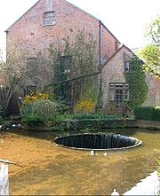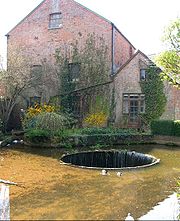
Tumbling Weir
Encyclopedia
The Tumbling Weir is a circular weir
in the town of Ottery St. Mary, Devon
, England
that allows water from a leat
or man-made stream to reach the River Otter
.
 It is apparently a rare design in that the water enters through a circular opening at the top that is surrounded by the stream. The water then cascades down some more smaller rings until it enters a culvert which enters a tunnel under the nearby path before sluicing down to the river a few metres away.
It is apparently a rare design in that the water enters through a circular opening at the top that is surrounded by the stream. The water then cascades down some more smaller rings until it enters a culvert which enters a tunnel under the nearby path before sluicing down to the river a few metres away.
industry. However, during the early part of the 18th century, this industry began to decline in the face of competition from cotton
and cheaper Yorkshire
yarns. Attempting to revive the local economy, Sir George Yonge and Sir John Duntze, Members of Parliament and joint Lords of the Manor, launched a scheme in 1788 to build a new manufactory at Ottery, for the carding
and spinning of wool, using the recently-invented water frame
machinery. At the same time, the original corn mill, which had stood here for 700 years, was demolished, and a new, much bigger one built.
The existing leat which supplied the old corn mill did not provide a sufficient head of water for the new mill, so the level of the water in the mill basin had to be raised by 2.4 metres. This was achieved by reducing the fall along the leat. Then, as now, the water level was maintained by the circular 'tumbling weir', which discharged the overflow into the river through a short tunnel. Water was conveyed from the mill basin to the 5.5 metre water wheel inside the factory (reported to be capable of producing 30 horsepower
) by an overhead aqueduct
- the factory launder. A second 3.6 metre overshot wheel powered the corn mill.
The corn mill, according to a notice in the Sherborne Mercury in 1835:
In 1824 the enterprise was converted to the manufacture of silk
, and up to 400 female workers were employed. In 1897 the factory was sold to Keetch & Co, brush manufacturers, the first of several subsequent owners.
The corn mill continued to operate until 1937; the factory launder was demolished in 1945.
Weir
A weir is a small overflow dam used to alter the flow characteristics of a river or stream. In most cases weirs take the form of a barrier across the river that causes water to pool behind the structure , but allows water to flow over the top...
in the town of Ottery St. Mary, Devon
Devon
Devon is a large county in southwestern England. The county is sometimes referred to as Devonshire, although the term is rarely used inside the county itself as the county has never been officially "shired", it often indicates a traditional or historical context.The county shares borders with...
, England
England
England is a country that is part of the United Kingdom. It shares land borders with Scotland to the north and Wales to the west; the Irish Sea is to the north west, the Celtic Sea to the south west, with the North Sea to the east and the English Channel to the south separating it from continental...
that allows water from a leat
Leat
A leat is the name, common in the south and west of England and in Wales, for an artificial watercourse or aqueduct dug into the ground, especially one supplying water to a watermill or its mill pond...
or man-made stream to reach the River Otter
River Otter
Not to be confused with the animal Otter or the River Ottery in CornwallThe River Otter rises in the Blackdown Hills just inside the county of Somerset, near Otterford, then flows south for some 32 km through East Devon to the English Channel at the western end of Lyme Bay, part of...
.

History
From medieval times the production of wool cloth was a major DevonDevon
Devon is a large county in southwestern England. The county is sometimes referred to as Devonshire, although the term is rarely used inside the county itself as the county has never been officially "shired", it often indicates a traditional or historical context.The county shares borders with...
industry. However, during the early part of the 18th century, this industry began to decline in the face of competition from cotton
Cotton
Cotton is a soft, fluffy staple fiber that grows in a boll, or protective capsule, around the seeds of cotton plants of the genus Gossypium. The fiber is almost pure cellulose. The botanical purpose of cotton fiber is to aid in seed dispersal....
and cheaper Yorkshire
Yorkshire
Yorkshire is a historic county of northern England and the largest in the United Kingdom. Because of its great size in comparison to other English counties, functions have been increasingly undertaken over time by its subdivisions, which have also been subject to periodic reform...
yarns. Attempting to revive the local economy, Sir George Yonge and Sir John Duntze, Members of Parliament and joint Lords of the Manor, launched a scheme in 1788 to build a new manufactory at Ottery, for the carding
Carding
Carding is a mechanical process that breaks up locks and unorganised clumps of fibre and then aligns the individual fibres so that they are more or less parallel with each other. The word is derived from the Latin carduus meaning teasel, as dried vegetable teasels were first used to comb the raw wool...
and spinning of wool, using the recently-invented water frame
Water frame
The water frame is the name given to the spinning frame, when water power is used to drive it. Both are credited to Richard Arkwright who patented the technology in 1768. It was based on an invention by Thomas Highs and the patent was later overturned...
machinery. At the same time, the original corn mill, which had stood here for 700 years, was demolished, and a new, much bigger one built.
The existing leat which supplied the old corn mill did not provide a sufficient head of water for the new mill, so the level of the water in the mill basin had to be raised by 2.4 metres. This was achieved by reducing the fall along the leat. Then, as now, the water level was maintained by the circular 'tumbling weir', which discharged the overflow into the river through a short tunnel. Water was conveyed from the mill basin to the 5.5 metre water wheel inside the factory (reported to be capable of producing 30 horsepower
Horsepower
Horsepower is the name of several units of measurement of power. The most common definitions equal between 735.5 and 750 watts.Horsepower was originally defined to compare the output of steam engines with the power of draft horses in continuous operation. The unit was widely adopted to measure the...
) by an overhead aqueduct
Aqueduct
An aqueduct is a water supply or navigable channel constructed to convey water. In modern engineering, the term is used for any system of pipes, ditches, canals, tunnels, and other structures used for this purpose....
- the factory launder. A second 3.6 metre overshot wheel powered the corn mill.
The corn mill, according to a notice in the Sherborne Mercury in 1835:
has three pairs of stones, a Bolting Mill, Rubble Machine and Smut Machine, with extensive Lofts; they are driven by a very powerful stream affording a never-failing supply of water and are capable of making at least one hundred sacks a week.
In 1824 the enterprise was converted to the manufacture of silk
Silk
Silk is a natural protein fiber, some forms of which can be woven into textiles. The best-known type of silk is obtained from the cocoons of the larvae of the mulberry silkworm Bombyx mori reared in captivity...
, and up to 400 female workers were employed. In 1897 the factory was sold to Keetch & Co, brush manufacturers, the first of several subsequent owners.
The corn mill continued to operate until 1937; the factory launder was demolished in 1945.

